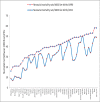Perinatal mortality trends in Ethiopia
- PMID: 25489181
- PMCID: PMC4249204
- DOI: 10.4314/ejhs.v24i0.4s
Perinatal mortality trends in Ethiopia
Abstract
Background: Although the magnitude of perinatal mortality in Ethiopia was among the highest in Sub Saharan Africa, there was no systematic review done to assess the trend and causes of perinatal death. The objective of this review was to assess the trend of perinatal mortality rate (PMR) and the causes attributed to perinatal deaths.
Methods: Studies included in this systematic review were sixteen hospital and community based perinatal mortality studies, which were conducted between 1974 and 2013 using data concerning Ethiopia accessed either electronically or from local journals. The trend of PMR, stillbirth rate (SBR) and early neonatal mortality rate (ENMR) were given emphasis.
Results: The PMRs reported from ten hospital based studies were in the range of 66 to 124 per 1000 births. The reports of the large scale community based PMRs were in the range of 37 to 52 per 1000 births. The proportion of stillbirths and early neonatal deaths reported from the hospital based and community based studies was very high (60-110 and 20-34/1000 births); the regression lines demonstrated that SBRs in the hospitals were mirror reflections of ENMRs in the community. The neonatal mortality rate (NMR), however, declined by more than 40% between 1990 and 2011.
Conclusion: The PMR of Ethiopia was among the highest in Sub Saharan Africa. Over the decades, both hospital based and community based studies did not show a reduction in perinatal mortality. The trend of perinatal mortality rate has been stable between 90 and 40 per 1000 total births in the hospital and community setting, respectively. The significant reduction in NMR was due to significant decline in late neonatal mortality.
Keywords: Ethiopia; causes; early neonatal mortality rate; perinatal mortality; stillbirth rate; trend.
Figures







References
-
- World Health Organization (WHO), author Neonatal and perinatal mortality: country, regional & global estimates. Geneva, Switzerland: 2006.
-
- Lawn JE, Kerber K, Enweronu-Laryea C, Cousens S. Stat DM. 3.6 Million Neonatal Deaths—What Is Progressing and What Is Not? Semin Perinatol. 2010;34:371–386. - PubMed
-
- Lawn JE, Cousens S, Zupan J. 4 million deaths: When? Where? Why? The Lancet. 2005;365(9462):891–900. - PubMed
-
- Trends in Maternal Mortality: 1990 to 2010 WHO, UNICEF, UNFPA and The World Bank estimates. Retrieved from: http://whqlibdoc.who.int.
-
- Hogan MC, Foreman KJ, Naghavi M, et al. Maternal mortality for 181 countries, 1980-2008: a systematic analysis of progress towards Millennium Development Goal 5. The Institute of Health Metrics and Evaluation (IHME) at the University of Washington in Seattle, USA. Lancet. 2010;375:1609–1623. - PubMed
Publication types
MeSH terms
LinkOut - more resources
Full Text Sources
Medical
